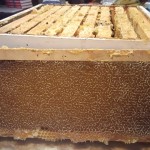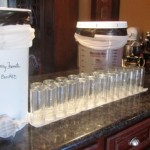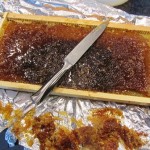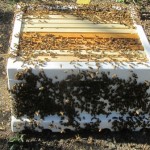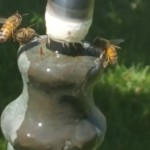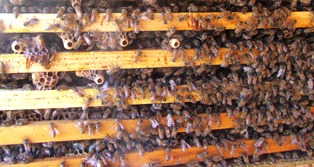Harvesting Honey–Helping Hands Always Welcome
When it comes to opening the hives of honey bees here on our farmette, I’m grateful for the helping hands of my hubby and my neighbor. Carlos, my hubby and helpmate for life, is my go-to guy for all our farm projects. And our neighbor Peter not only has answers to my questions about bees, but also he can open a hive, remove frames of honey, inspect and medicate, and seal the unit lickety-split.
With the smoker at the ready and lit, we opened our hives September 23, 2018. The hives were robust, but the bees appeared stressed. I had added supers to each hive in late July but should have kept a closer eye on the burgeoning bee population. They had become overcrowded and hungry.
For harvesting, we first removed the heavy metal lid of the hive box, replacing it with a fume board. A fume board is a lid lined with fabric that is sprayed with a product that encourages the bees to vacate the supers (some bees immediately leave the box; others go into the brood chambers). The fume board works within seven to ten minutes. We then pulled out the frames of honey, gently brushed off any remaining bees, and took the honey-heavy frames to the kitchen.
For an old hand at beekeeping like my neighbor, the process went quick. Not so for me. This past year, I injured both my shoulders with tears in the rotator cuff tendons. With limitation to some of my range of motion, I’ve felt pretty handicapped. Still, I helped by carrying a single frame of honey at a time from the hive box to the kitchen.
While the hives were open, we removed old medicated strips previously hung in the boxes to thwart mites.
- Small sheets for trapping hive beetles are placed across the frames in the top super before closing the lid
We also replaced the Bee-Gone sheets to trap hive beetles. It’s important to properly handle such items and to keep the apiary clean. We put in medication for mite control–a white gelatinous substance spread on a paper similiar to an index card. Finally, we placed a single patty of bee food on the frames to provide for the bees’ nutritional needs.
The bees immediately coalesced on the patty; no longer stressed, they seemed gentle and calm. Checking the bottom frames, we found a lot of brood (eggs, larvae and pupae of bees). To help this new generation of honey bees along, we inserted an unopened frame of honey that I’d kept wrapped in foil and frozen (freezing kills any insects that could infect the hive or bees). Honey, of course, is the perfect food for them.
We will reopen the hives in two weeks and re-check the status of the bees. A that time, we’ll treat with an antibiotic for winter and possibly add a super if necessary.
I haven’t yet processed the honey we harvested but the frames are on my kitchen counter. They are in a hive box wrapped in aluminum foil. At the ready are also several food-grade buckets that I’ve carefully washed, dried, and covered with lids. The honey spinning machine has been cleaned. Before I begin working with the honey in the frames, I always scrub my kitchen, washing the countertops twice–first with soap and water and then with diluted bleach and hot water.
When everything is clean, I will begin to work on each frame. I first scrape away any bee “glue” from the outside edges of the frame. With a hot knife, I slice all around the interior edges before opening the sealed wax cells (sliding the hot knife just under the wax and lifting). Both sides of the frame are dealt with in this manner. After the wax cells are uncapped, the frame will be placed into the spinning machine. It uses centrifugal force to spin off the honey. The sweet stuff then drains through the strainer material taped around the bucket mouth. The bucket is positioned under the machine spigot.
My reward for this labor of love is having an abundance of sweet, amber honey when desired to bake a honey cake or other culinary creation, to enjoy a relaxing cup of tea, or to fill jars for holiday gift-giving. Beekeeping draws people together and, take it from me, a helping hand is always appreciated.
_______________________________________________________________________________
If you enjoy reading about keeping bees and chickens, growing heirloom vegetables and fruits, or living the farmette (small farm) life, check out my offering of books that tie into themes of living well and close to the Earth.
Grab one or more of my cozy mysteries (no gratuitous sex, profanity, or violence) and discover delicious farm recipes, gardening advice, and tips for caring for bees and chickens.
Or pick up one of my wellness, spirituality, or manifesting books. They make great holiday gifts for yourself and others.
All my books are available in traditional bookstores everywhere and also online at Amazon.com, Barnes & Noble (barnesandnoble.com), Kobo Books, Walmart, and other retailers.
For more information, click on the following URLs:
A HIVE OF HOMICIDES
MURDER OF A QUEEN BEE
A BEELINE TO MURDER

More than 150 rituals for sound mind, strong body, and meaningful connections to the people around you
https://www.amazon.com/dp/B0719HHVRJ/ref=dp-kindle-redirect?_encoding=UTF8&btkr=1
A Hive of Homicides or Hive Demise
The title of the third novel in my Henny Penny Farmette series suggests loss of bees and murderous intent. No beekeeper wants to lose a hive, regardless of how it happens–whether some invader wants to kill the bees, go after the honey, or use the hive as a host for proliferation of its own species.
I’m not one-hundred percent positive why I lost a hive this year. My best guess was that the demise was due (not to homicide but rather) to a tiny little pest, possibly a beetle that weakened it so that the bees and queen fled leading to the hive’s demise.
My beekeeper neighbor and I spotted a small beetle and treated for it. My best efforts to keep my small bee house and the area around it clean as well as doing frequent hive inspections wasn’t enough. Now, I’m considering moving my remaining hive onto a higher, drier, sunnier location.
I’ll do it at night which is the correct time to move bees. You just put a little strip of packing foam along the hive entrance, gently move the hive, and place it in the new location. Remove the foam strip so the bees can leave at dawn and make sure there’s a water source nearby.
The bees will likely accept the move if there is water and food in the area. I like planting perennial bee gardens and flowers and bulbs with high nectar value for bloom throughout the year.
Since hives can be compromised by wax moths, hive beetles, and other pests (as well as parasites and diseases), frequent inspections to decipher a problem and treat it before it destroys your hive is imperative.
With supers (smaller hive boxes with ten frames each) on the hive in June, the bees will forage on abundant flowers and produce honey that can be taken off in July. That’s also the time to inspect for mites because these populations tend to swell during summer.
________________________________________________________________
If you’re interested in beekeeping and other farmette topics, check out my Henny Penny Farmette series of mysteries. All are available to order online at Amazon, Barnes and Noble, and other retailer sites as well as traditional bookstores everywhere.
The Bees Won’t Wait
With so many flowers in bloom now, it’s time to add supers to the hives.
I can hear the buzzing from my patio, about twenty to thirty feet from the hives. My bees want to make honey, raise babies, and swarm . . . I know it.
My neighbor and I are opening hives tomorrow, but I worked out in the apiary today getting extensions (known as supers) ready. These have shorter frames and the bees use them to build wax cells and store honey.
I’ve got two active hives and extras. And I have several supers, complete with the shorter frames ready to go.
There are about ten frames I can use in a super that are being housed in the outdoor freezer. It’s where I put frames to kill anything that could live over on them that I don’t want in a hive, like a wax moth. The cold kills.
I also cleaned the bee glue off another hive box with larger frames in the event the bees decide to swarm sooner rather than later. The bees won’t wait. They’ll need a new house ready when they swarm or they’ll fly away and find one elsewhere.
 Facebook
Facebook Goodreads
Goodreads LinkedIn
LinkedIn Meera Lester
Meera Lester Twitter
Twitter




